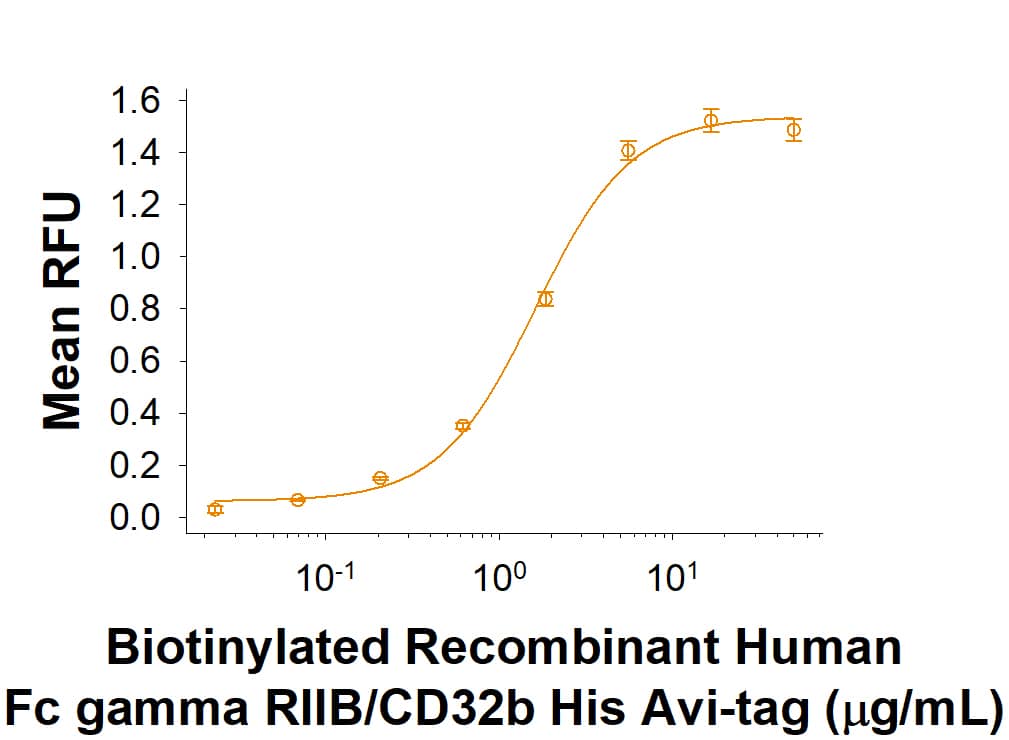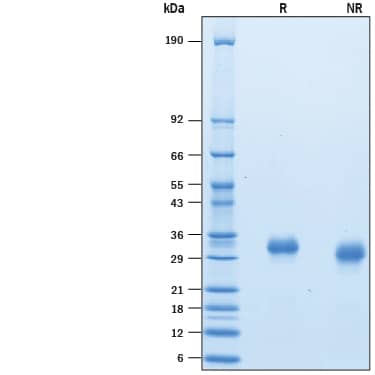Recombinant Human Fc gamma RIIB/CD32b Avi-tag Protein, CF
Recombinant Human Fc gamma RIIB/CD32b Avi-tag Protein, CF Summary
Learn more about Avi-tag Biotinylated ProteinsProduct Specifications
| Human Fc gamma RIIB/C (CD32b/c) (Ala46-Pro217) Accession # P31995.1 | HHHHHH | Avi-tag |
| N-terminus | C-terminus | |
Product Datasheets
Carrier Free
CF stands for Carrier Free (CF). We typically add Bovine Serum Albumin (BSA) as a carrier protein to our recombinant proteins. Adding a carrier protein enhances protein stability, increases shelf-life, and allows the recombinant protein to be stored at a more dilute concentration. The carrier free version does not contain BSA.
In general, we advise purchasing the recombinant protein with BSA for use in cell or tissue culture, or as an ELISA standard. In contrast, the carrier free protein is recommended for applications, in which the presence of BSA could interfere.
AVI1875
| Formulation | Lyophilized from a 0.2 μm filtered solution in PBS with Trehalose. |
| Reconstitution | Reconstitute at 500 μg/mL in PBS. |
| Shipping | The product is shipped at ambient temperature. Upon receipt, store it immediately at the temperature recommended below. |
| Stability & Storage: | Use a manual defrost freezer and avoid repeated freeze-thaw cycles.
|
Scientific Data
 View Larger
View Larger
When Normal Human IgG is immobilized at 10 μg/mL (100 μL/well), the concentration of Biotinylated Recombinant Human Fc gamma RIIB/CD32b His-tag Avi-tag (Catalog # AVI1875) that produces 50% of the optimal binding response is found to be approximately 0.5-3.0 μg/mL.
 View Larger
View Larger
2 μg/lane of Biotinylated Recombinant Human Fc gamma RIIB/C (CD32b/c) His-tag Avi-tag (Catalog # AVI1875) was resolved with SDS-PAGE under reducing (R) and non-reducing (NR) conditions and visualized by Coomassie® Blue staining, showing bands at 28-36 kDa.
Background: Fc gamma RIIB/C (CD32b/c)
Receptors for the Fc region of IgG (Fc gamma Rs) are members of the Ig superfamily that function in the activation or inhibition of immune responses such as degranulation, phagocytosis, ADCC (antibody-dependent cellular toxicity), cytokine release, and B cell proliferation (1-3). The Fc gamma Rs have been divided into three classes based on close relationships in their extracellular domains; these groups are designated Fc gamma RI (also known as CD64), Fc gamma RII (CD32), and Fc gamma RIII (CD16). Each group may be encoded by multiple genes and exist in different isoforms depending on species and cell type. The CD64 proteins are high affinity receptors (~10-8-10-9 M) capable of binding monomeric IgG, whereas the CD16 and CD32 proteins bind IgG with lower affinities (~10-6-10-7 M) only recognizing IgG aggregates surrounding multivalent antigens (1, 4). Fc gamma Rs that deliver an activating signal either have an intrinsic immunoreceptor tyrosine-based activation motif (ITAM) within their cytoplasmic domains or associate with one of the ITAM-bearing adapter subunits, FcR gamma or zeta (3, 5). The only inhibitory member in human and mouse, Fc gamma RIIB, has an intrinsic cytoplasmic immunoreceptor tyrosine-based inhibitory motif (ITIM). The coordinated functioning of activating and inhibitory receptors is necessary for successful initiation, amplification, and termination of immune responses (5).
Three distinct genes encode the human CD32 group, and the protein products are designated Fc gamma RIIA, B, and C (1). These receptors are glycoproteins of approximately 40 kDa having two extracellular Ig-like domains. The Fc gamma RII proteins share 94-99% amino acid identity in their extracellular domains but differ substantially in their transmembrane and cytoplasmic domains. Fc gamma RIIA associates with FcR gamma, and delivers an activating signal upon ligand binding (3, 5). In contrast, Fc gamma RIIB delivers an inhibitory signal. Fc gamma RIIC represents an unequal cross-over event between the IIA and IIB genes. Its extracellular domain shares 99% amino acid identity with Fc gamma RIIB, but a portion of the cytoplasmic domain is closely related to Fc gamma RIIA. Fc gamma RII proteins are expressed on cells of both myeloid and lymphoid lineages as well as on cells of non-hematopoietic origin.
- van de Winkel, J. and P. Capes (1993) Immunol. Today 14:215.
- Raghaven, M. and P. Bjorkman (1996) Annu. Rev. Cell Dev. Biol. 12:181.
- Ravetch, J. and S. Bolland (2001) Annu. Rev. Immunol. 19:275.
- Takai, T. (2002) Nature Rev. Immunol. 2:580.
- Ravetch, J. and L. Lanier (2000) Science 290:84.
FAQs
No product specific FAQs exist for this product, however you may
View all Proteins and Enzyme FAQsReviews for Recombinant Human Fc gamma RIIB/CD32b Avi-tag Protein, CF
There are currently no reviews for this product. Be the first to review Recombinant Human Fc gamma RIIB/CD32b Avi-tag Protein, CF and earn rewards!
Have you used Recombinant Human Fc gamma RIIB/CD32b Avi-tag Protein, CF?
Submit a review and receive an Amazon gift card.
$25/€18/£15/$25CAN/¥75 Yuan/¥2500 Yen for a review with an image
$10/€7/£6/$10 CAD/¥70 Yuan/¥1110 Yen for a review without an image
